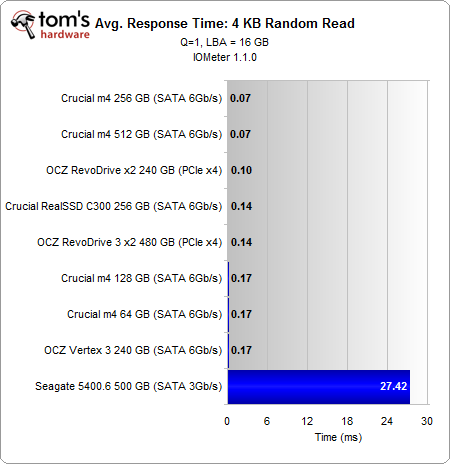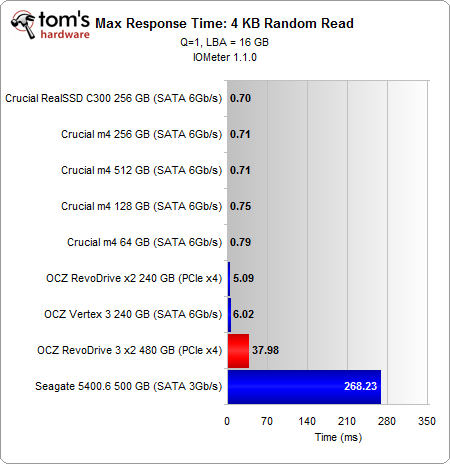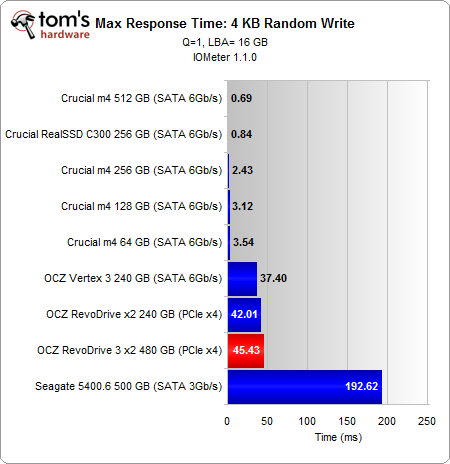The OCZ RevoDrive 3 X2 Preview: Second-Gen SandForce Goes PCIe
4 KB Random Performance: Response Time
It's really wrong to look at data rates (throughput) without taking latency and processing time into account. We're explained this before in tablet reviews with regard to WiFi throughput, but the same concept also applies to storage. Let's go back to the analogy of a phone call, because it easily illustrates why there's more to speed than just throughput.
Throughput is the audio quality. Latency is the amount of time from when you speak into the phone until the person on the other side hears you, and processing time is the delay for the person on the other line to think about what you said before answering back. If we apply this to SSDs, throughput is the amount of data you can send over time, latency is the lag due to data transmission, while processing time is the overhead incurred by the SSD when it receives the data.
Now consider that latency plus processing time equals response time. That's really what we're measuring in Iometer. This is a little confusing because Iometer uses the terms latency and response time interchangeably, but it's really only capable of measuring the latter.
In random reads, the RevoDrive 3 X2 has a response time of .14 ms, which is about 40% slower than the RevoDrive X2. Interestingly, the Vertex 3 is the slowest SSD with a response time of 0.17 ms.
Write response time is another matter. The 240 GB Vertex 3, 256 GB m4, 512 GB m4, and both RevoDrives tie for the top spot with a response time of 0.07 ms.
Keep in mind that response time is a measure of the difference between initiating and completing an operation, while throughput is a measure of the amount of data transferred. These two values affect performance in different ways, but they don't stack up. So it's not like the 64 GB drive "feels" 75% slower than the 128 GB drive (25% slower throughput + 50% slower response time). Throughput and response time are usually correlated, in that you get high throughput with low response time. In the event that they don't, it's more like having a high-quality phone call with a long lag time or vice versa.
The max response time offers a look at the extremes. In random reads, the RevoDrive 3 X2 only beats out the 5400.6 Seagate hard drive. That's about 6x slower than the RevoDrive X2 and Vertex 3.
Get Tom's Hardware's best news and in-depth reviews, straight to your inbox.
All of the OCZ SSDs fall behind once we look at the maximum write response time, though you need to keep this in perspective. The improvement over a hard drive is what you'll experience most viscerally, rather than the difference between a Vertex 3 and an m4.
OCZ uses SandForce controllers, which means there's a little garbage collection occurring after every write op. RevoDrive 3 X2 doesn't really seem all that different from what we from its predecessor, which suggests that OCZ didn't change its algorithms to the point of affecting performance in this metric.
Current page: 4 KB Random Performance: Response Time
Prev Page 4 KB Random Performance: Throughput Next Page 128 KB Sequential Performance-
warmon6 ReplyIt's not a business-class product. It's for the power user who is able to tax it using the right workload. If you're not one of those folks, the RevoDrive 3 X2 is seriously overkill.
OVERKILL?!?!
Nothing is overkill in the computer arena in terms of performance. :p
Just the price can be over kill. o.0 -
acku Santa is going to need a bigger expense account... :)Reply
Personally, I'm hoping that OCZ adds TRIM prior to September.
Cheers,
Andrew Ku
TomsHardware.com -
greenrider02 I saw defense of the Vertex 3's occasional low numbers, but no mention of the solid (and sometimes better) performance that the cheaper and more miserly Crucial m4 showed throughout your tests.Reply
Perhaps you have some bias towards the Vertex 3 that needs reconsideration?
Other than that, $700 seems like a fair price when considering the performace difference, especially if utilized properly, for instance as a high traffic web/corporate server -
acku greenrider02I saw defense of the Vertex 3's occasional low numbers, but no mention of the solid (and sometimes better) performance that the cheaper and more miserly Crucial m4 showed throughout your tests.Perhaps you have some bias towards the Vertex 3 that needs reconsideration?Other than that, $700 seems like a fair price when considering the performace difference, especially if utilized properly, for instance as a high traffic web/corporate serverReply
If you read the first page then you know that I give a nod to Vertex 3s as the fastest MLC based 2.5" SSD. I consider that plenty of love. :).
We'll discuss the lower capacity m4s in another article. FYI, I suggest that you read page 5 and page 6. We are not testing FOB. We are testing steady state. That's part of the reason the SF-based drives are behaving differently with incompressible data.
On your second point, this is in no way targeted toward an enterprise environment (that's what Z-drives are for). There is no redundancy in the array if a single SF controller fails. The whole card is a dud afterward. You can add higher level redundancy, but enterprise customers have so far been nervous on SandForce products. Plus, there's a general preference for hardware vs. software redundancy. (That's them talking not me). Overall, this makes it unacceptable for any enterprise class workload.



